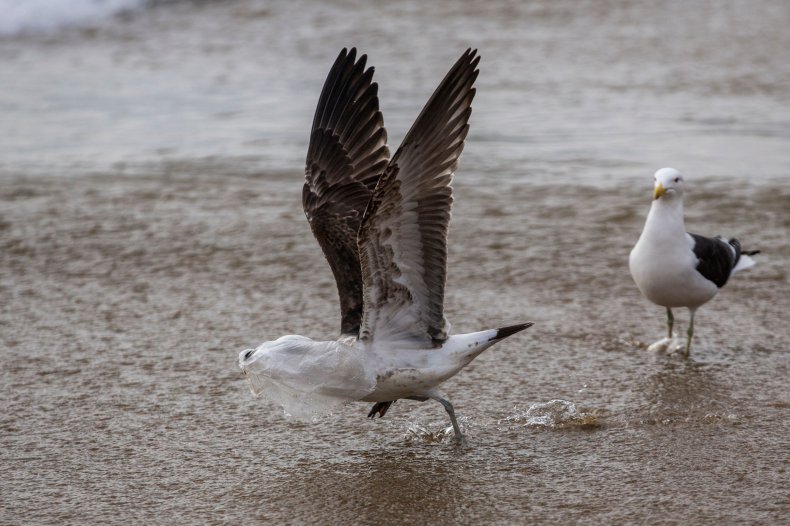For a study published in the journal Current Biology, a team of scientists led by Shouta Nakayama from Hokkaido University fed plastic pellets to young streaked shearwater chicks living in a cliff colony on Awashima Island, Japan. [ANIMAL EXPERIMENTATION ON WILD ANIMALS IS JUST WRONG]
They found this resulted in the accumulation of chemical additives in the liver and fatty tissues of the seabirds in quantities up to 120,000 times higher than the amount they would receive from their natural diet.
The team also monitored six seabird species living in the wild in Hawaii, finding similar results in those animals that ingested relatively high quantities of plastic. According to the team, these results suggest that the consumption of plastic debris can be a "major pathway of chemical pollutants into seabirds."
"These findings provide direct evidence of seabird exposure to plastic additives and emphasize the role of marine debris ingestion as a source of chemical pollution in marine organisms," the authors wrote in the study.
Plastic debris is widespread in the marine environment around the world. A 2015 study found that every year, eight million tonnes of the material makes its way into the planet's oceans.
With so much plastic entering the oceans, the number of species that ingest plastic debris is increasing, as environmentalists raise concerns about the impact this will have on marine animals.
Among these animals, seabirds are particularly vulnerable to plastic pollution as they have high rates of ingestion, often mistaking the material for food. One study found that since the 1960s, between 45 and 78 percent of all seabird species have been documented eating plastics.
Meanwhile, a paper published in the journal Proceedings of the National Academy of Sciences suggested that by 2050, 99 percent of all seabird species will be ingesting plastic.
Plastic consumption can lead to blockages and injury in the digestive tract—which can sometimes be fatal—but it can also expose the animals to hazardous chemicals. This is because plastics often have chemicals added to them during the manufacturing process, while toxic substances which are already present in seawater can also become attached to the material.

A seagull struggles to take flight covered by a plastic bag, on the seashore at Caleta Portales beach in Valparaiso, Chile on July 17, 2018.CLAUDIO REYES/AFP VIA GETTY IMAGES
"The many toxic chemicals present and their adverse effects on those organisms that ingest plastics raise concerns about individual health and population-level impacts," the authors wrote in the study.
Previous studies on wild seabirds have indicated that plastic-derived chemicals may be able to accumulate in their body tissue. However, all of this evidence was indirect and it was not clear whether the plastic was the source of the pollutants. The researchers conducted the latest study in order to obtain direct evidence for the transfer and accumulation of plastic additives in the tissue of seabirds.
While the latest study indicates that these chemicals can accumulate in seabirds, at present it is not clear what the health impacts are on marine animals, so more research is needed in this area.
"This study demonstrates that plastics do lead to raised levels of contaminants in seabird chicks, Samantha Patrick from the University of Liverpool, who was not involved in the study, told the BBC. "This is an important step forward in our understanding of how plastics affect marine species."
Seabirds around the world in peril, with around half of known species experiencing—or thought to be experiencing—population declines, while 28 percent are considered globally threatened, according to the International Union for Conservation of Nature.
"The many toxic chemicals present and their adverse effects on those organisms that ingest plastics raise concerns about individual health and population-level impacts," the authors wrote in the study.
Previous studies on wild seabirds have indicated that plastic-derived chemicals may be able to accumulate in their body tissue. However, all of this evidence was indirect and it was not clear whether the plastic was the source of the pollutants. The researchers conducted the latest study in order to obtain direct evidence for the transfer and accumulation of plastic additives in the tissue of seabirds.
While the latest study indicates that these chemicals can accumulate in seabirds, at present it is not clear what the health impacts are on marine animals, so more research is needed in this area.
"This study demonstrates that plastics do lead to raised levels of contaminants in seabird chicks, Samantha Patrick from the University of Liverpool, who was not involved in the study, told the BBC. "This is an important step forward in our understanding of how plastics affect marine species."
Seabirds around the world in peril, with around half of known species experiencing—or thought to be experiencing—population declines, while 28 percent are considered globally threatened, according to the International Union for Conservation of Nature.
No comments:
Post a Comment